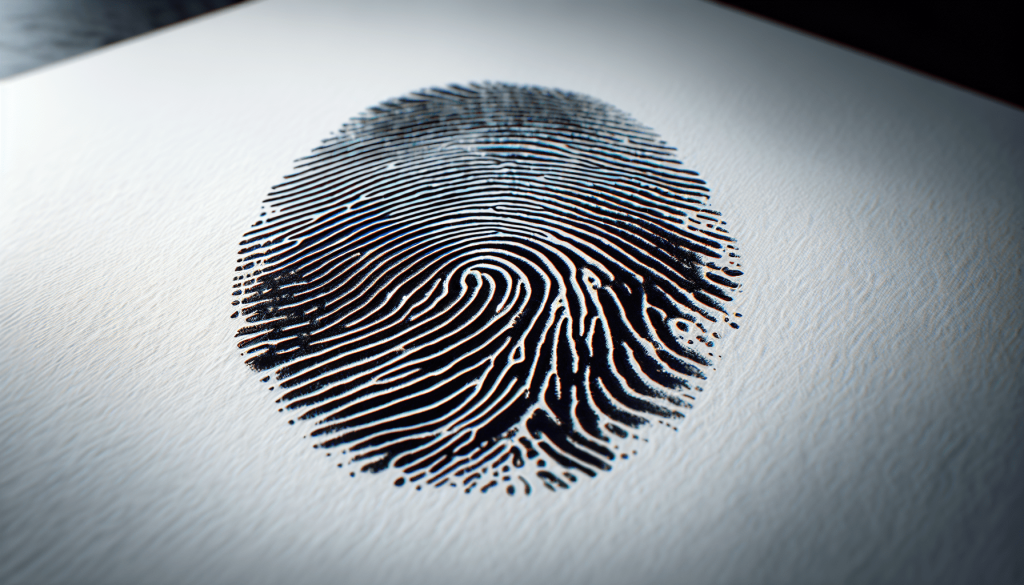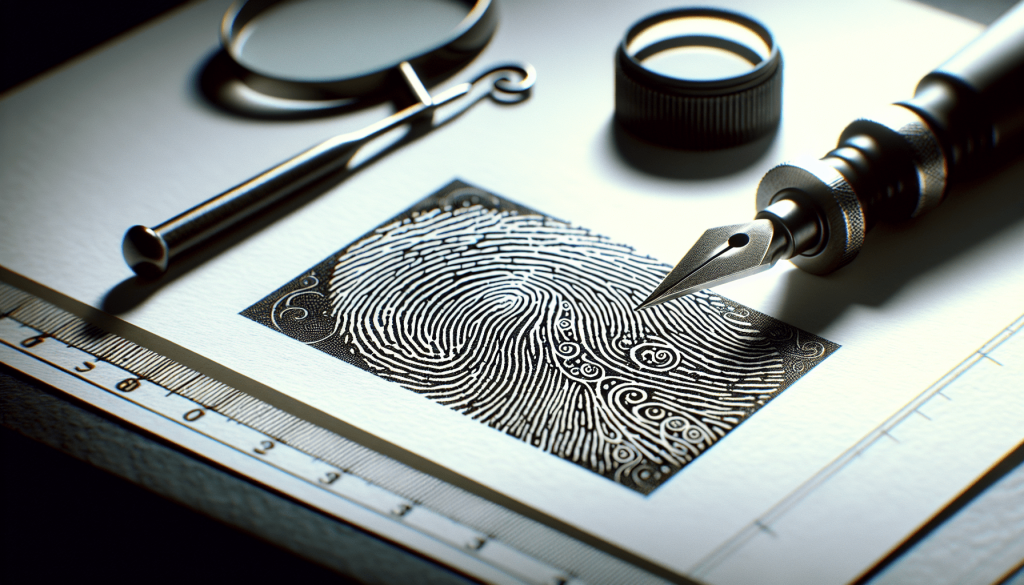Have you ever wondered if it’s possible to transfer your ink fingerprints into a digital format for electronic records? In a world where technology continues to advance at lightning speed, the digitization of traditional methods is becoming increasingly common. This article aims to explore the fascinating and somewhat complex process of converting ink fingerprints into digital records, examining the feasibility, challenges, and benefits of this transformation.

Understanding Fingerprints
What Are Fingerprints?
Fingerprints, unique to each individual, are essentially patterns of ridges and valleys on the tips of your fingers. These patterns are formed during fetal development and remain unchanged throughout your life. They play a crucial role in biometric identification, as no two people (not even identical twins) have the same fingerprints.
Types of Fingerprint Patterns
There are several primary patterns that fingerprints can form:
| Pattern Type | Description |
|---|---|
| Whorl | Circular or spiral patterns covering about 30-35% of fingerprint patterns. |
| Loop | Forms a loop configuration and covers roughly 60-65% of fingerprint patterns. |
| Arch | Simplest pattern, with ridges entering one side and exiting the other, covering 5-10%. |
Understanding these patterns helps in grasping the complexity involved in capturing and digitizing fingerprints.
The Traditional Ink Method
How Ink Fingerprints Are Collected
Ink fingerprinting has been a longstanding method for capturing fingerprints. The process typically involves applying ink to the fingers and pressing them onto a paper card to produce a physical record. This method, while effective, has been surpassed by more advanced digital techniques.
Limitations of Ink Fingerprints
Despite its ubiquity, ink fingerprinting has several drawbacks:
- Messiness: Handling ink can be cumbersome and prone to smudging.
- Storage Issues: Physical cards require ample storage space and are susceptible to damage.
- Transference: Copying ink fingerprints onto other documents can degrade their quality and integrity.
The Push Towards Digital Fingerprints
Why Digitize Fingerprints?
Digitizing fingerprints offers several compelling advantages:
- Storage Efficiency: Digital records can be stored securely with minimal physical space.
- Accessibility: Easily shareable among different departments or agencies.
- Enhanced Security: Encryption and other cybersecurity measures can protect digital records better than physical copies.
How Are Fingerprints Digitized?
Digitizing fingerprints involves capturing the ridge and valley details electronically using scanners or specialized biometric devices. Here’s a simplified breakdown:
- Scanning: A finger is placed on a digital scanner, which records the intricate details of the print.
- Processing: Software algorithms enhance and convert the captured image into a digital format.
- Storage: The digital file is then stored in a database or electronic record system for future use.

Converting Existing Ink Fingerprints
Can Old Ink Fingerprints Be Digitized?
Yes, converting existing ink fingerprints into a digital format is possible but comes with its own set of challenges. This typically involves scanning the physical ink fingerprint cards and then using image processing software to enhance and digitize the prints.
Detailed Process of Digitization
- High-Resolution Scanning: First, the ink fingerprint card is scanned using a high-resolution scanner to capture all details.
- Image Enhancement: Specialized software enhances the scanned image, ensuring clarity and accuracy.
- Data Conversion: The enhanced image is converted into a digital format, often involving complex algorithms to simulate the exact ridge and valley patterns.
- Quality Check: The digital fingerprint is then verified for quality and accuracy before being stored in a database.
Challenges in Digitizing Ink Fingerprints
Converting ink fingerprints to a digital format isn’t devoid of challenges:
- Image Quality: Old or smudged prints can be difficult to digitize accurately.
- Software Limitations: Not all image processing software can handle the intricacies of fingerprint patterns.
- Manual Intervention: Sometimes, manual corrections are needed to ensure the quality of the digitized print.
Benefits of Digitized Fingerprints
Improved Efficiency
One of the most significant benefits of digitizing fingerprints is the improvement in efficiency. Digital records can be quickly searched, retrieved, and shared, significantly speeding up various processes such as background checks and identity verification.
Enhanced Security
Digital fingerprints can be encrypted and stored securely, reducing the risk of tampering and unauthorized access. Biometric databases often incorporate multiple layers of security, ensuring that sensitive data remains protected.
Environmentally Friendly
By reducing the need for physical paper records, digitized fingerprints contribute to environmental sustainability. This transition not only saves paper but also reduces the carbon footprint associated with storage and transportation.
Real-world Applications of Digitized Fingerprints
Law Enforcement
For law enforcement agencies, digitized fingerprints have revolutionized the way in which crimes are solved. Databases like Automated Fingerprint Identification Systems (AFIS) have made it possible to match fingerprints from crime scenes quickly, aiding in the swift apprehension of suspects.
Border Control and Immigration
Digitized fingerprints play a crucial role in border security and immigration control. Many countries now require biometric information, including fingerprints, as part of their visa and entry processes. This ensures that people entering the country are accurately identified and tracked.
Banking and Finance
Banks and financial institutions are increasingly using digitized fingerprints for secure customer identification. This biometric data can be used for services such as opening accounts, authorizing transactions, and accessing safe deposit boxes, ensuring that only authorized individuals can perform these actions.
Healthcare
In the healthcare sector, digitized fingerprints help maintain accurate patient records and facilitate secure access to medical histories. They can also be used to quickly identify patients in emergency situations, ensuring they receive the appropriate care based on their medical history.
Technological Advances
Biometric Scanners
Modern biometric scanners have evolved to provide highly accurate and quick fingerprint capture. These scanners use advanced sensors to capture detailed patterns without the need for ink. Here’s a comparison of traditional and modern methods:
| Feature | Traditional Ink Method | Modern Biometric Scanners |
|---|---|---|
| Handling | Messy | Clean, ink-free |
| Accuracy | Variable, prone to errors | Highly accurate |
| Storage | Physical storage required | Digital storage |
| Retrieval Speed | Slow | Instantaneous |
Cloud Storage
With the advent of cloud computing, storing and accessing digitized fingerprints has become even more efficient. Cloud storage solutions offer redundancy, scalable storage, and remote accessibility, making them an ideal choice for large-scale biometric databases.
Artificial Intelligence (AI)
AI plays a significant role in enhancing the digitization process. Machine learning algorithms can be trained to identify and correct imperfections in scanned fingerprints, improving the overall quality and accuracy of the digitized records.
Legal and Ethical Considerations
Privacy Concerns
The digitization of fingerprints raises important privacy issues. It is crucial to ensure that biometric data is handled with the utmost care, adhering to stringent privacy laws and regulations. Unauthorized access or misuse of this sensitive information could have severe repercussions.
Regulatory Compliance
Various laws govern the use of biometric data, and compliance is non-negotiable. Organizations must ensure that their digitization processes comply with regulations such as GDPR (General Data Protection Regulation) in Europe, and other local data protection laws in different regions.
Ethical Implications
Ethically, it is essential to use digitized fingerprints responsibly. This means obtaining informed consent from individuals before collecting their biometric data and ensuring transparency about how the data will be used, stored, and protected.
The Future of Fingerprint Digitization
Integration with Other Biometrics
As technology continues to develop, fingerprint digitization will likely integrate with other biometric identification methods such as facial recognition and iris scans. This multi-biometric approach will enhance security and reliability in identity verification processes.
Decentralized Storage
Blockchain technology offers a decentralized approach to storing digitized fingerprints, providing an added layer of security and integrity. Each fingerprint can be stored as a unique block, making tampering nearly impossible.
Wearable Technology
Imagine a future where wearable devices can capture and store your fingerprints in real-time. These innovations could provide continuous, seamless authentication for various applications, from unlocking your phone to securing online transactions.
Conclusion
So, can ink fingerprints be digitized for electronic records? The answer is a resounding yes. While the process may be complex and fraught with challenges, the benefits far outweigh the difficulties. From improved efficiency and enhanced security to environmental sustainability, digitizing fingerprints opens up a world of possibilities.
By understanding the intricacies of fingerprint patterns, leveraging modern technology, and adhering to legal and ethical guidelines, you can successfully transition from traditional ink methods to a more sophisticated, digital approach. The future of fingerprint digitization is not just promising; it’s already unfolding before our eyes.

